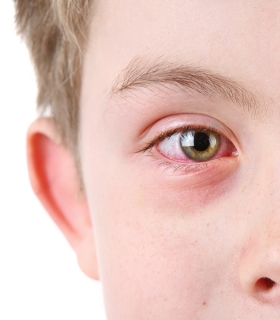How to Identify and Treat Your Child’s Pinkeye
Article at a Glance
- Pinkeye is usually not serious and requires little intervention except keeping the area comfortable and clean.
- Antibiotics are not necessary—or even effective—in most cases.
- Help prevent pinkeye spreading by practicing good hand hygiene and sanitizing objects that come into frequent contact with hands and faces.
Each of us has a thin layer of tissue covering the whites of our eyes—the conjunctiva. When this tissue becomes red and swollen, we call the condition conjunctivitis or pinkeye. While unattractive and sometimes uncomfortable, pinkeye is rarely serious.
Practically speaking, pinkeye is similar to the common cold. Both conditions can be passed along to other children, but both usually get better without medical intervention.
What Are the Different Kinds of Pinkeye, and How Do They Spread?
Bacterial Pinkeye
- Both eyes can be affected.
- Eyes can be red, itchy, or painful.
- There can be green or yellow discharge in the eyes that accumulates throughout the day.
- Eyes may be crusted shut after sleep.
Incubation period: This is unknown because most of our eyes already contain the bacteria in non-infection-causing levels.
Contagious period ends: Twenty-four hours after treatment begins.
Viral Pinkeye
- Eyes can be pink, swollen, and watery.
- Eyes may be sensitive to light.
- One or both eyes can be affected.
Incubation period: Often accompanies the early stages of a viral respiratory illness that include other symptoms.
Contagious period: Common types of viral conjunctivitis are contagious while symptoms are present. Adenovirus, a type of viral conjunctivitis that often accompanies fever, sore throat, or other respiratory symptoms, can be contagious for weeks after symptoms abate.
Chemical Pinkeye
- Eyes can be red and watery.
- Eyes can burn.
- Eyes may be sensitive to light.
- Only the exposed eye is affected.
Reaction period: Symptoms appear just after exposure—such as after swimming in a chlorinated pool.
Contagious period: None.
Allergic Pinkeye
- Both eyes are usually affected.
- Eyes may water excessively and itch.
Reaction period: Symptoms could present immediately or be delayed several hours after contact with the allergen.
Contagious period: None.
Immunity-Related Pinkeye
Some systemic diseases, such as Kawasaki disease, include pinkeye among their symptoms.
Does My Child Need Antibiotics?
Antibiotics serve no benefit in treating viral, chemical, allergic, or immune-related pinkeye. According to the American Academy of Pediatrics, antibiotics shorten the infection period of even bacterial conjunctivitis only slightly.
How Can I Help My Child Feel Better?
- Help clear any discharge by gently cleansing eyes with warm water and a clean cotton ball every few hours. Remember to wash your hands before and after.
- Artificial tears can help ease irritation. Use one drop per eye, three times daily as needed, after cleansing the eye.
- Help redness with a long-lasting vasoconstrictor type of eyedrop sold over the counter.
- Children who wear contact lenses should switch to glasses while symptoms are present.
How Can I Control the Spread of Pinkeye?
Like the common cold, the spread of pinkeye can be limited by teaching children good hand hygiene:
- Wash hands before touching the eyes, nose, and mouth.
- Sanitize objects that come in contact with hands or faces, such as door knobs, light switches, desks, and tables as well as children’s blankets, toys, and pillows.
Call your doctor right away if your child meets any of the following criteria:
- Is 12 weeks old or younger and has a fever. Do not give fever medication before calling.
- Has red eyes and a fever at any age.
- Has a red or swollen eyelid or eye pain.
- Is experiencing nonstop watering and blinking, blurred vision, or sensitivity to light.
- Has pus in the eye.
- Seems seriously ill.
Additional Resources
Eye – Red Without Pus
Share this article:
